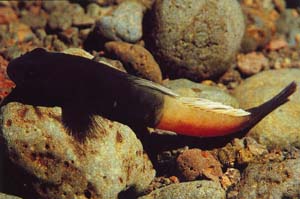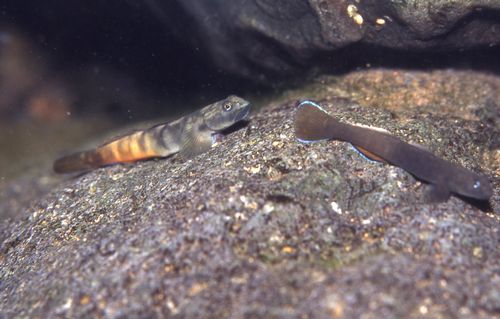
Lentipes concolor
FAMILY
Gobiidae
TAXONOMY
Sicyogaster concolor Gill, 1860, Hilo, Hawaii. Part of the sub
FAMILY
Sicydiinae.
OTHER COMMON NAMES
Hawaiian: ‘alamo’o.
PHYSICAL CHARACTERISTICS
To 5.3 in (13.4 cm) total length. A tubular species with a blunt
head, subterminal mouth, and rounded caudal fin. Pelvic fins
are united to form a cup and adhere to the body. Gray or
brownish trunk with irregular lateral markings that sometimes
form bands. Breeding males transform from the drab color to
black on the anterior half of the body, and red or white tinged
with red posteriorly, with white median fins.
DISTRIBUTION
Hawaiian Islands.
HABITAT
Adults and juveniles ascend waterfalls to inhabit headwaters
and upper reaches of perennial rain-forest streams on the high
islands of the Hawaiian archipelago. It has been reported from
sites as high as 2,947 ft (900 m) above sea level. This species
has planktonic marine larvae.
BEHAVIOR
Larvae of this amphidromous species wash out to sea where
they may remain for a period of three months. Post-larvae return
to fresh water, and ascend waterfalls to colonize the upper
reaches of streams; sicydiine gobies probably use their pelvic
fins and their teeth to gain purchase on the rock surface as
they climb waterfalls. Genetic evidence suggests that they do
not return to the natal stream.
FEEDING ECOLOGY AND DIET
Predominantly herbivorous, has rows of fine teeth that are ideal
for scraping algae from the surface of rocks in the stream bed.
As the old teeth break or wear down, they are replaced by fresh
teeth. Freshwater shrimps are also taken in small numbers.
REPRODUCTIVE BIOLOGY
Breeds from October through June. Males may establish and patrol
reproductive territories, but evidence for this is inconclusive.
Males defend nest cavities prior to breeding and pair with females
prior to spawning for two to six days. Spawning may last several
hours, during which females deposit eggs on the underside of the
roof of the nest cavity before being chased out by the male. Individual
females may spawn four clutches a season, with an average
of nearly 14,000 eggs. After spawning, males apparently guard the
nests. Although not directly observed, males may also clear detritus
from nest cavities. Eggs hatch in three to six days.
CONSERVATION STATUS
Not currently threatened; classified as Data Deficient by the
IUCN. This species was listed as a Category 1 candidate for
Endangered Species classification by the U.S. Fish and
Wildlife Service from 1989 to 1996. It was removed from the
list when it was discovered to be more widely abundant than
previously believed. Many populations were not identified prior
to listing, in part because upstream sites were undersampled.
SIGNIFICANCE TO HUMANS
No commercial value.
Photo Gallery of - O’opo alamo’o





 Animalia Life
Animalia Life